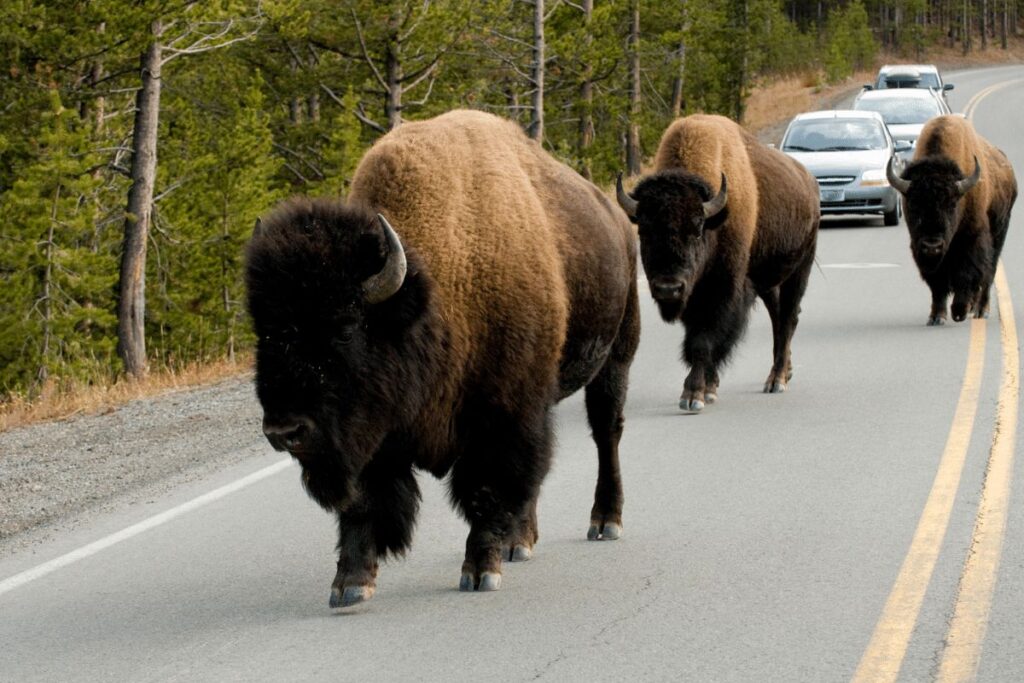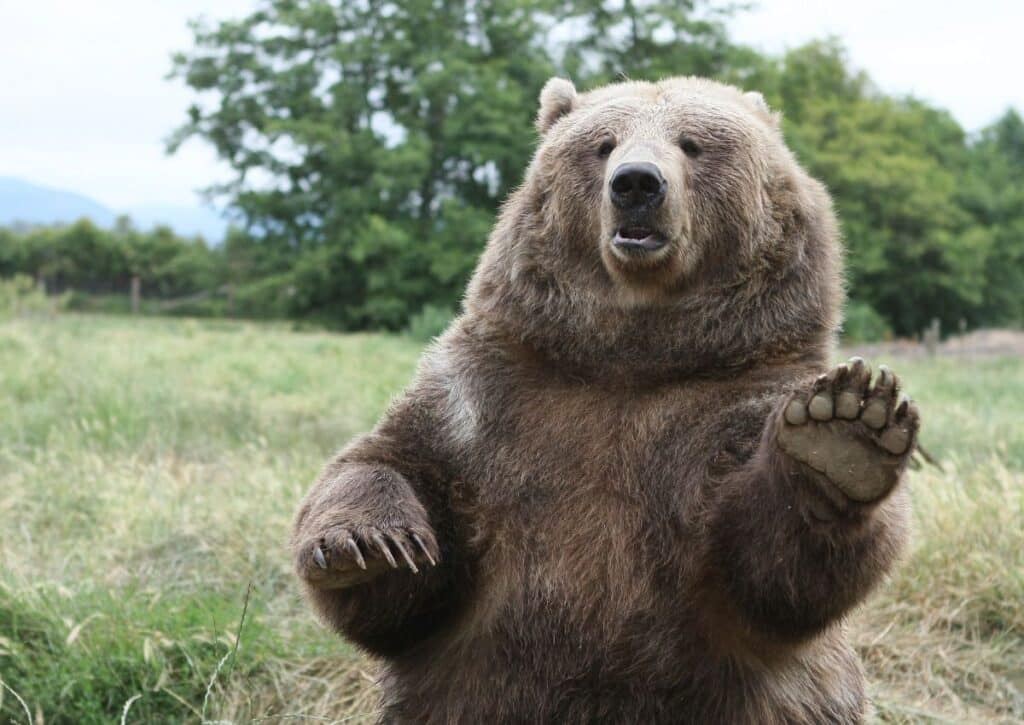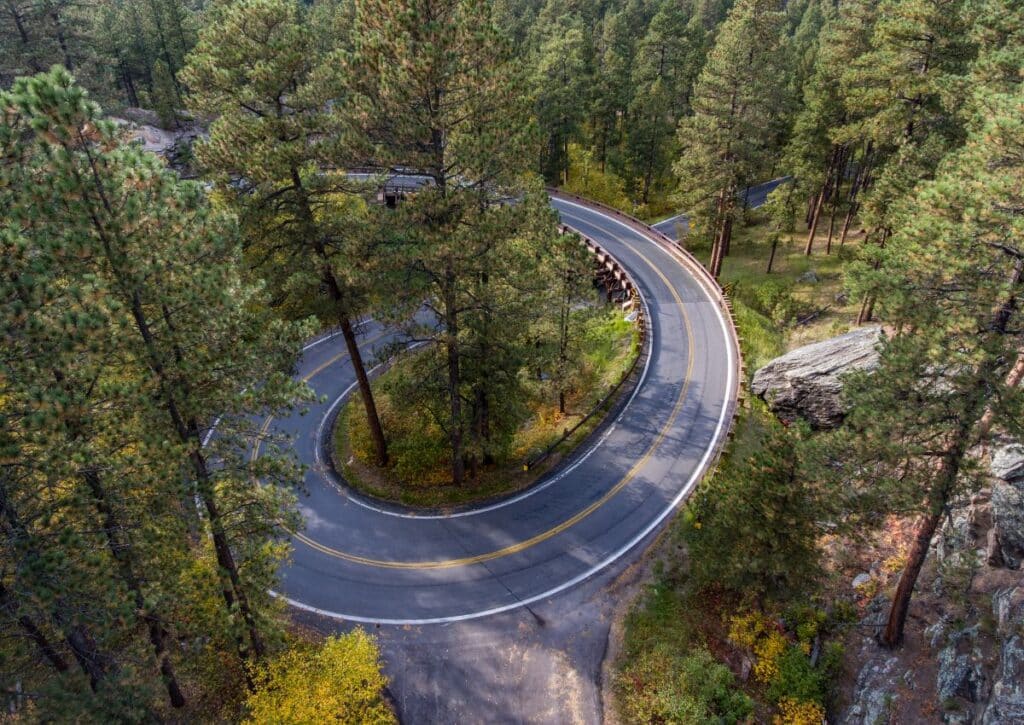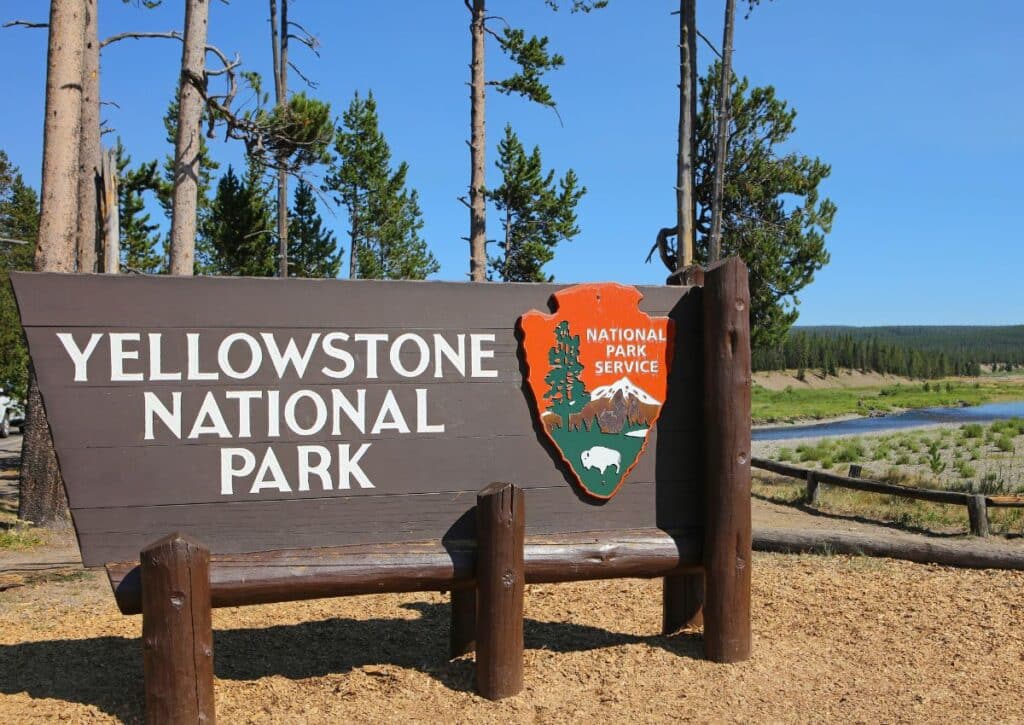Explore 15 majestic animals in Yellowstone this spring! Dive into captivating stories, sighting tips, and ethical guidance for a thrilling safari adventure.
Embarking on a journey to Yellowstone and curious about its mesmerizing animal kingdom? You’ve landed in the right place!
Join us as we whisk you away on an exhilarating virtual safari, navigating the untamed terrains of America’s iconic first national park.
From the mighty American Bison to the elusive Long-Tailed Weasel, we’ll unveil the stories of Yellowstone’s legendary residents and introduce you to its hidden gems.
But that’s not all! Alongside these tales of nature’s wonders, we’ll arm you with essential tips on the best spots to witness these creatures in their natural habitat and guide you on how to do so ethically and safely.
So, ready your adventurous spirit (and maybe those binoculars too) as we set off on this wildlife odyssey!
American Bison
The American bison is the largest land animal in North America. Bison can weigh up to 2,200 pounds (1,000 kilograms) and can stand 6 feet (2 meters) tall at the shoulder. The American bison is made up of two subspecies: the plains bison and the wood bison.
The American bison is a powerful and muscular animal. It has a large head with short, black horns, and a shaggy brown coat.
The front part of the body is heavier than the rear, making it look like the bison is humped. This humped appearance is more pronounced in bulls (male bison) than in cows (female bison).
Bison are herd animals and live in groups called herds. Herds can be made up of just a few animals or hundreds of animals. Bison travel together to find food and to mate. During the winter months, herds will often join together to stay warm.
Bison are good swimmers and can even swim across rivers that are half a mile wide! Bison are also good jumpers and can leap over obstacles that are 6 feet high.
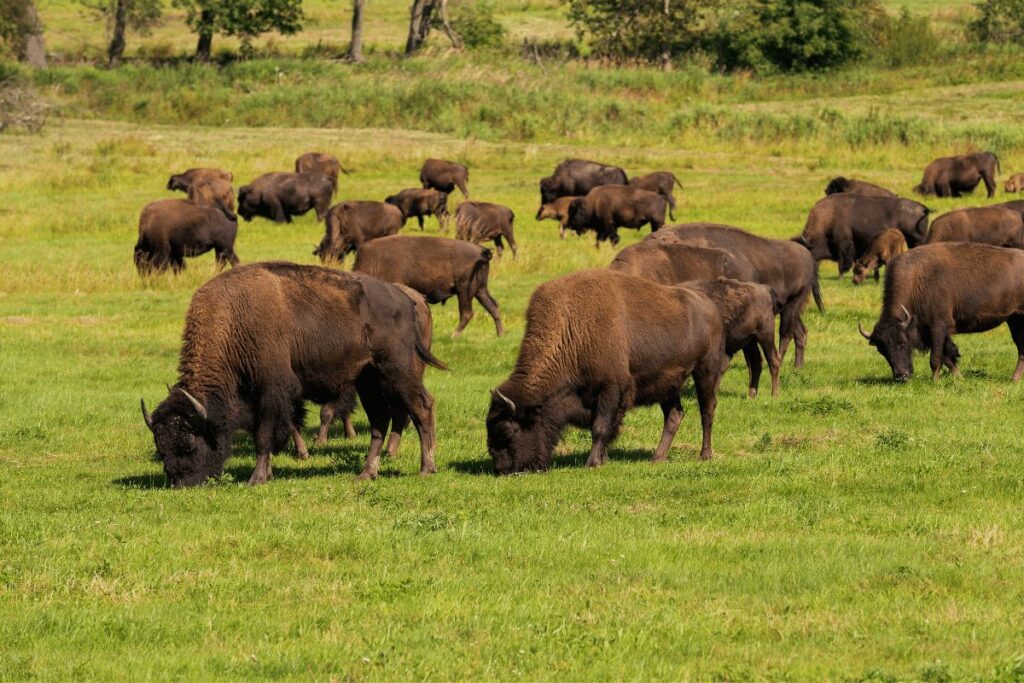
Yellowstone National Park is home to the largest herd of wild bison in the United States. In spring, these bison can be found throughout the park as they move to different areas to graze and calve. Here are a few places in Yellowstone where you are likely to see bison in the spring:
Lamar Valley: This is one of the best places to see bison in Yellowstone, especially in the spring. The Lamar Valley is a large open valley where bison like to graze, and it’s not uncommon to see large herds of them here.
Hayden Valley: This is another large open valley where bison can often be seen in the spring. The Hayden Valley is located in the central part of the park, and it’s a great place to spot wildlife in general.
Upper Geyser Basin: The Upper Geyser Basin is home to some of the most famous geysers in Yellowstone, but it’s also a great place to see bison in the spring. The bison here are used to the crowds of tourists, so they tend to be fairly relaxed.
Norris Geyser Basin: This is another popular spot for bison in the spring. The Norris Geyser Basin is located in the northwestern part of the park, and it’s known for its geothermal features and abundant wildlife.
Remember, bison are wild animals, and it’s important to keep a safe distance from them. Yellowstone National Park requires visitors to stay at least 25 yards (23 meters) away from bison at all times.
Gray Wolves
As you travel through Yellowstone this spring, keep your eyes peeled for gray wolves! These majestic animals were once on the brink of extinction, but thanks to conservation efforts, they are now thriving in the park.
Keep your distance if you see one, as they are still wild animals. If you’re lucky enough to spot a wolf pack, you’ll be treated to a truly unique and unforgettable experience.
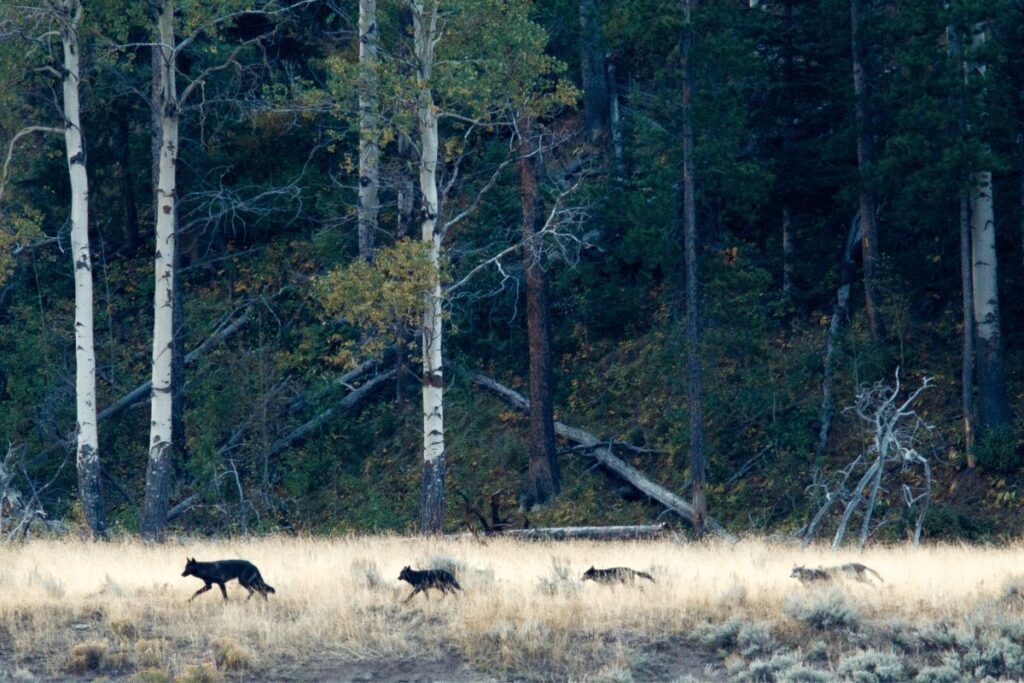
Yellowstone National Park is one of the best places in the world to see wolves in the wild. Here are a few places in Yellowstone where you are likely to see wolves, including some lesser-known wilderness areas:
Lamar Valley: This is the most famous place to see wolves in Yellowstone. The Lamar Valley is located in the northeastern part of the park and is home to the Lamar Canyon pack, one of the most well-known wolf packs in the world.
Hayden Valley: This large valley in the central part of the park is also a great place to spot wolves. Hayden Valley is home to several wolf packs, including the Mollie’s pack.
Bechler Region: This is a less-visited area of the park located in the southwestern corner of Yellowstone. The Bechler region is known for its backcountry trails and waterfalls, but it’s also home to a few wolf packs.
Pelican Valley: This is a remote wilderness area located in the northeastern part of Yellowstone. The Pelican Valley is home to several wolf packs, including the Canyon pack, which is known for its unique gray wolf and coyote hybrid.
Remember, seeing wolves in the wild is a rare and special experience, and it’s important to give these animals the space and respect they deserve.
Elk
Elk are one of the most popular animals to see in Yellowstone. They are often seen grazing near the road, and sometimes even crossing the road.
While they may seem docile, it is important to keep your distance as they are wild animals and can be dangerous if they feel threatened.
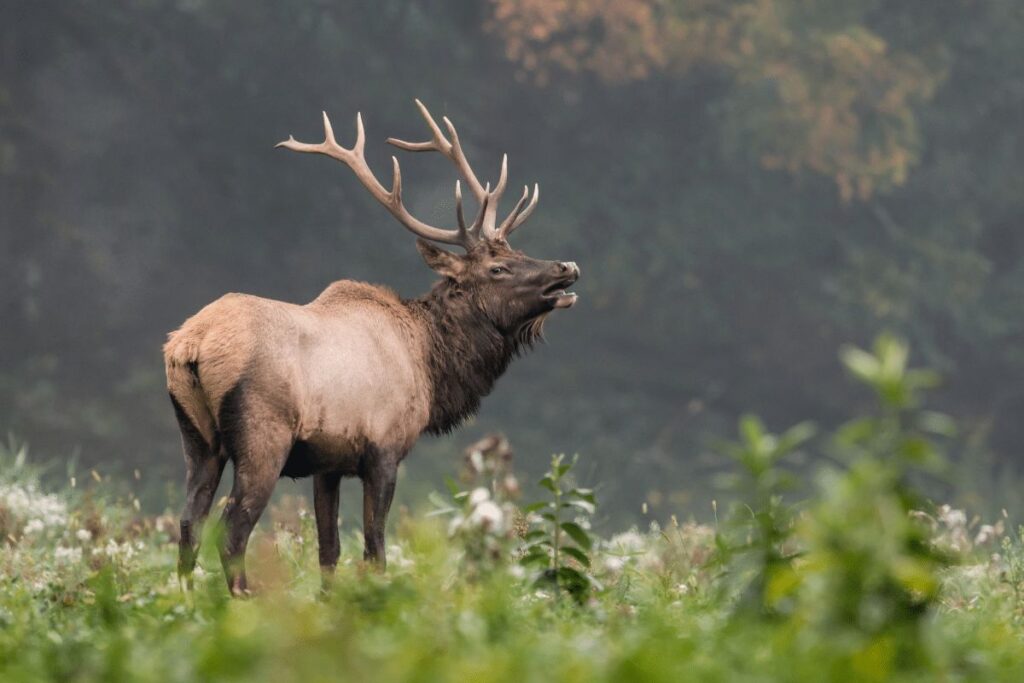
Yellowstone National Park is home to one of the largest elk populations in the world. Here are a few places in Yellowstone where you are likely to see elk, including some lesser-known wilderness areas and trails:
Mammoth Hot Springs: This is a popular area for elk sightings, particularly during the fall mating season. Mammoth Hot Springs is located in the northwestern part of the park and is easily accessible by car.
Lamar Valley: This valley is a great place to spot wildlife in general, including elk. The Lamar Valley is located in the northeastern part of the park and is accessible by car or by hiking the Lamar River Trail.
Blacktail Plateau Drive: This scenic drive is located in the northern part of the park and is a good place to see elk and other wildlife. The Blacktail Plateau Drive is a 6-mile loop that can be driven in about an hour.
Slough Creek Trail: This trail is located in the northeastern part of the park and is known for its wildlife sightings, including elk. The Slough Creek Trail is a 10-mile round trip hike that offers beautiful views of the surrounding wilderness.
Remember, while elk may appear tame, they are wild animals and can be dangerous if approached too closely. It’s important to give these animals plenty of space and observe them from a safe distance.
Mountain Lions (Cougars)
Mountain lions are some of the most dangerous animals in Yellowstone. They typically avoid humans but can be aggressive if they feel threatened or are protecting their young. If you see a mountain lion, do not approach it and keep your distance. If you are attacked by a mountain lion, fight back with whatever you have.
These majestic big cats are one of the most powerful and agile predators in North America, and spotting one in the wild is a truly thrilling experience.
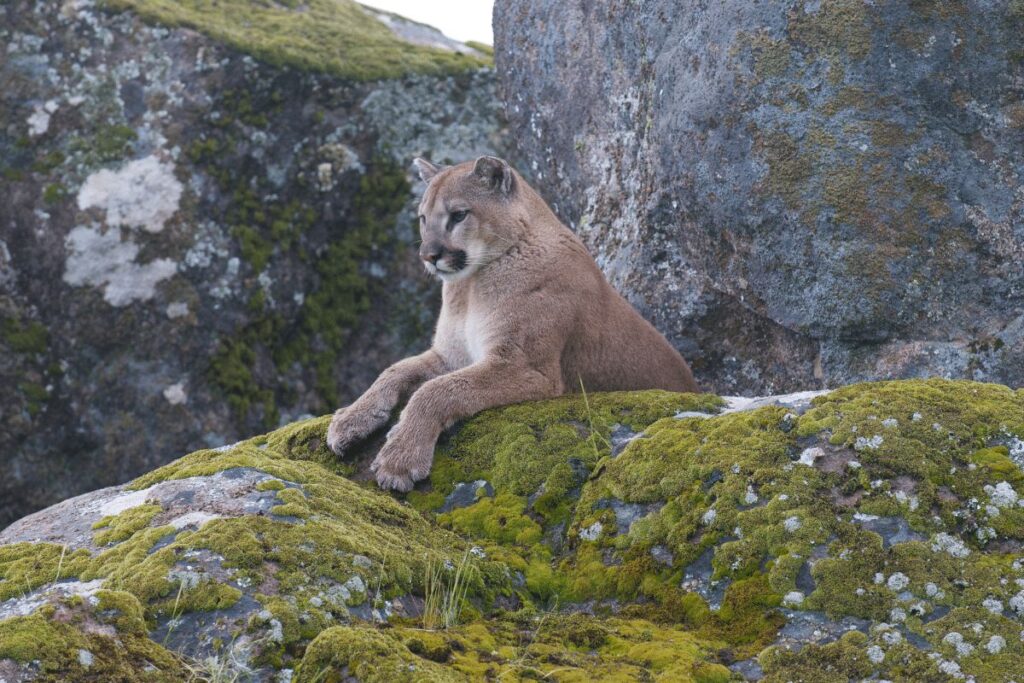
Here are some places you are likely too see mountain lions when you visit Yellowstone this Spring.
The Lamar Valley is a vast wilderness area in the northeastern part of the park that is home to a wide variety of wildlife, including mountain lions.
This area is known for its sweeping vistas, rolling hills, and abundant wildlife, and it’s not uncommon to spot a mountain lion stalking its prey through the grasslands.
Some popular hiking trails in the Lamar Valley include the Lamar River Trail and the Specimen Ridge Trail.
Hayden Valley is another great spot to see mountain lions in Yellowstone. This area is known for its expansive meadows and winding rivers, which provide an ideal habitat for these big cats.
Some popular hiking trails in the Hayden Valley include the Mary Mountain Trail and the Mud Volcano Trail.
Bechler Region
The Bechler Region is located in the southwestern corner of the park and is known for its rugged terrain and stunning waterfalls.
This remote wilderness area is home to a thriving population of mountain lions, as well as other wildlife such as black bears and elk.
Some popular hiking trails in the Bechler Region include the Bechler Meadows Trail and the Iris Falls Trail.
Mount Washburn Trail
The Mount Washburn Trail is one of the most popular hiking trails in Yellowstone, and it’s also a great spot to see mountain lions.
This trail climbs to the summit of Mount Washburn, which offers stunning views of the surrounding wilderness areas. Along the way, hikers may spot a mountain lion or two, so be sure to keep your eyes peeled.
Blacktail Plateau Drive
If you’re looking to see mountain lions from the comfort of your car, the Blacktail Plateau Drive is a great option.
This scenic drive winds through the heart of Yellowstone’s wilderness areas and offers spectacular views of the park’s wildlife.
Keep an eye out for mountain lions along the way, as they are known to roam the area.
Bighorn Sheep
These majestic creatures can often be seen grazing along the side of the road or climbing up steep hillsides. Although they are not as common as some of the other animals on this list, bighorn sheep are definitely worth keeping an eye out for!
Bighorn sheep are one of the more elusive animals in Yellowstone National Park, but there are a few areas where you are likely to spot them.
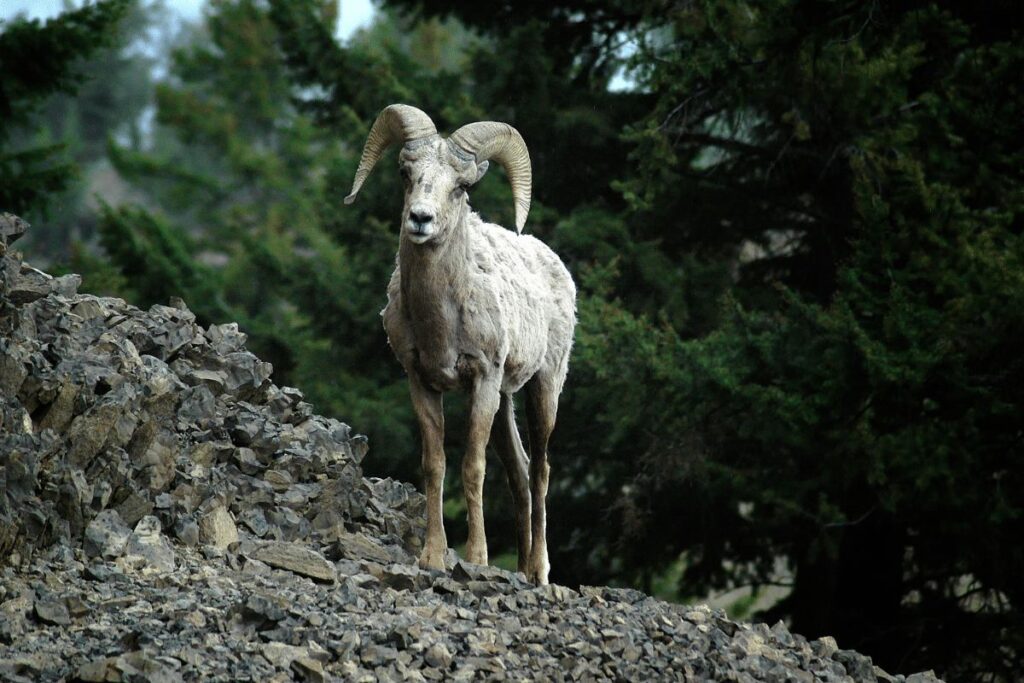
Here are a few places in Yellowstone where you might see bighorn sheep, including some lesser-known wilderness areas and trails:
Mount Washburn: This is one of the best places to see bighorn sheep in Yellowstone. Mount Washburn is a 10,243-foot peak located in the central part of the park, and the trail to the summit is a popular hiking route that offers stunning views and the chance to spot bighorn sheep.
Gardiner Canyon: This is a lesser-known area of the park located in the northwestern corner of Yellowstone. Gardiner Canyon is a beautiful canyon that is home to a small population of bighorn sheep.
Hellroaring Trail: This trail is located in the northeastern part of the park and is known for its wildlife sightings, including bighorn sheep. The Hellroaring Trail is a 6-mile round trip hike that offers stunning views of the surrounding mountains and valleys.
Remember, bighorn sheep are wild animals and can be difficult to spot. It’s important to be patient and keep a safe distance from these animals if you do encounter them.
Also Read: Exploring Yellowstone National Park: The 11 Must-See Sites You Shouldn’t Miss
Bears
Bears are one of the most popular animals to see while driving through Yellowstone in the spring! They are often seen along roadsides or in open meadows and can be active at any time of day.
Be sure to give them plenty of space and never approach bears, especially mothers with cubs.
Yellowstone National Park is home to both black bears and grizzly bears, and there are several areas of the park where you are likely to spot them.
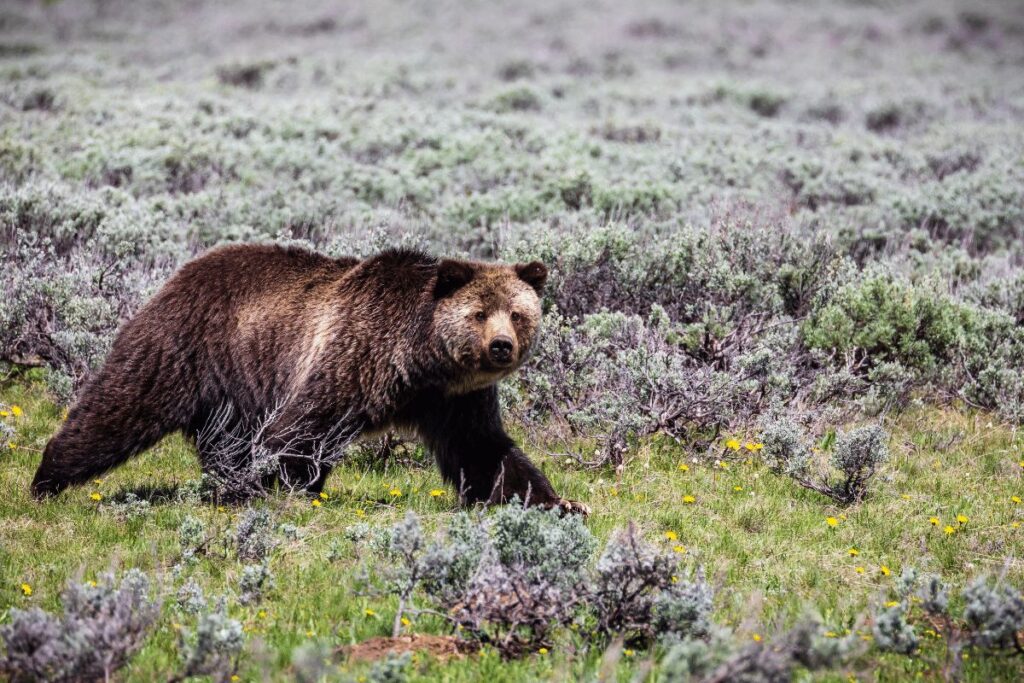
Here are a few places in Yellowstone where you might see bears, including some lesser-known wilderness areas and trails:
Hayden Valley: This large valley in the central part of the park is a great place to spot both black bears and grizzly bears. Hayden Valley is also a popular spot for elk and bison sightings.
Lamar Valley: This valley in the northeastern part of the park is known for its wildlife sightings, including bears. The Lamar Valley is home to both black bears and grizzly bears, and it’s also a popular spot for wolf sightings.
Bechler Region: This is a less-visited area of the park located in the southwestern corner of Yellowstone. The Bechler region is known for its waterfalls and hot springs, but it’s also a good place to spot bears.
Trout Lake Trail: This trail is located in the northeastern part of the park and is a popular spot for bear sightings. The Trout Lake Trail is a 1.2-mile round trip hike that offers stunning views of the surrounding mountains and forests.
Remember, bears are wild animals and can be dangerous if approached too closely. It’s important to give these animals plenty of space and observe them from a safe distance.
Coyotes
As you drive through Yellowstone National Park in the spring, you might see a coyote or two! The best time to spot them is early in the morning or at dusk. Keep your eyes peeled for these cunning canids as they prowl the roadsides looking for food.
Coyotes are common residents of Yellowstone and can be found throughout the park. They are most active at dawn and dusk, but can also be seen during the day.
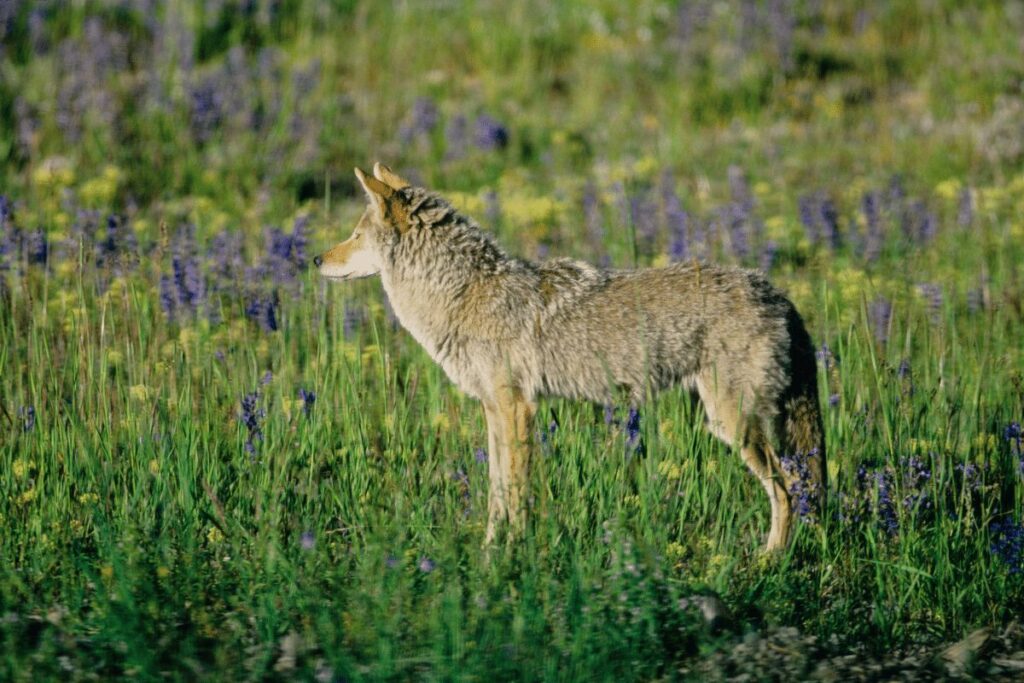
Coyotes are relatively small animals, measuring about three feet long and weighing around 30 pounds. They have pointy ears, a bushy tail, and are generally brownish-gray in color with light-colored fur on their belly and undersides.
Coyotes are opportunistic feeders and will eat just about anything they can find. In Yellowstone, they primarily eat mice and voles, but they will also eat rabbits, birds, fish, insects, fruit, and carrion. Coyotes will even occasionally kill and eat larger prey such as deer fawns or elk calves.
While coyotes typically avoid humans, they may become bold if they learn to associate people with food. Never feed coyotes!
If you do encounter a coyote while hiking in Yellowstone (or anywhere else), make yourself as big as possible by waving your arms and yelling loudly. If that doesn’t scare the coyote away, throw rocks or sticks at it until it leaves. And remember – never turn your back on a coyote
Mountain Goats
Mountain goats are one of the most sure-footed animals in North America. They spend their lives in high, rocky places where few other animals can go. In Yellowstone, you can find them high on cliffs or near the top of mountains, grazing on grasses and lichens.
These hardy creatures can even survive in winter by eating snow for water.
Mountain goats are not native to Yellowstone National Park, but a small population was introduced to the area in the 1940s.
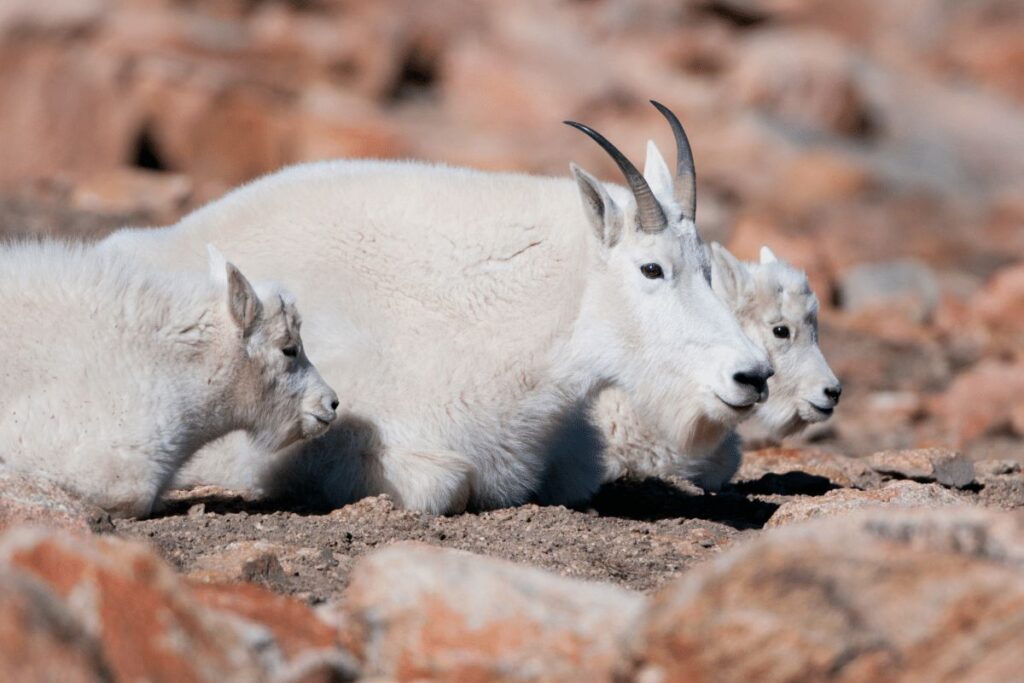
Here are a few places in Yellowstone where you might see mountain goats, including some lesser-known wilderness areas and trails:
Mount Washburn: This peak in the central part of the park is a popular spot for mountain goat sightings. The trail to the summit of Mount Washburn is a 6-mile round trip hike that offers stunning views and the chance to spot mountain goats.
Avalanche Peak Trail: This trail is located in the southeastern part of the park and is a popular spot for mountain goat sightings. The Avalanche Peak Trail is a 2.3-mile round trip hike that offers stunning views of the surrounding mountains and valleys.
Electric Peak Trail: This trail is located in the northern part of the park and is another good spot for mountain goat sightings. The Electric Peak Trail is a strenuous 20-mile round trip hike that offers stunning views of the surrounding wilderness.
Remember, mountain goats are wild animals and can be dangerous if approached too closely. It’s important to give these animals plenty of space and observe them from a safe distance.
Moose
Among the animals, you might see while driving through Yellowstone National Park in the spring are moose. These majestic creatures are the largest members of the deer family, and can weigh up to 1,600 pounds! Moose are most active in the early morning and evening hours, so keep your eyes peeled for them along roadsides and in meadows. If you’re lucky enough to spot a moose, take care not to approach too closely – give them plenty of space to go about their day.
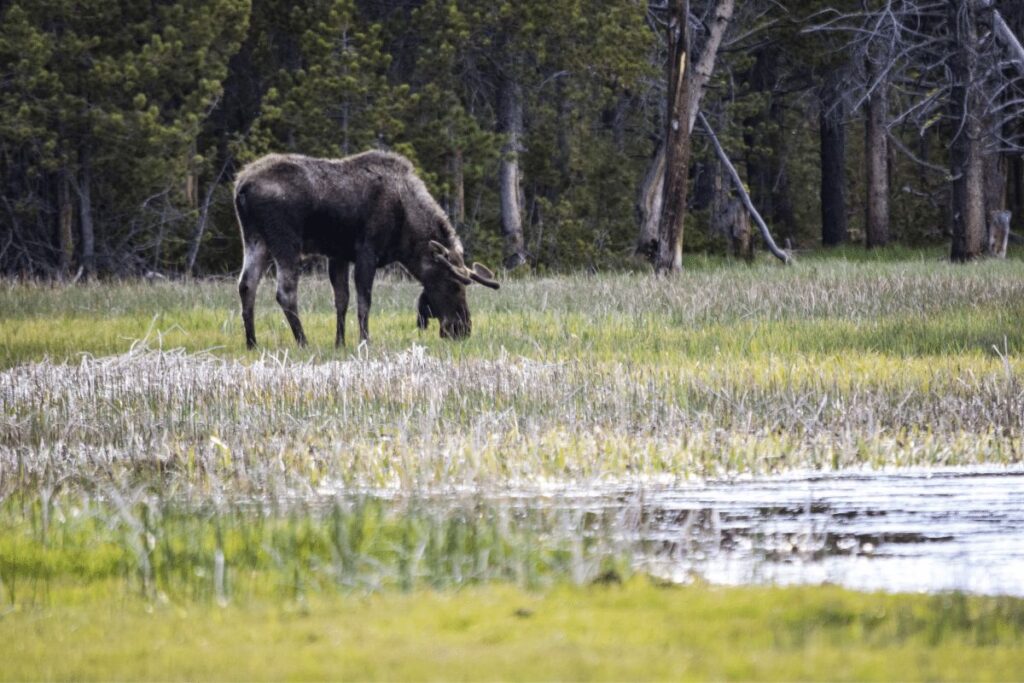
Moose are not as commonly found in Yellowstone National Park as other wildlife, but there are a few areas where you may have a chance to spot them. Here are a few places in Yellowstone where you might see moose, including some lesser-known wilderness areas and trails:
Pelican Valley: This is a remote area of the park located in the northeastern part of Yellowstone. Pelican Valley is a marshy area that is home to a small population of moose.
Snake River: The Snake River runs through the southern part of Yellowstone and is a good spot to look for moose. Moose are often seen near the river’s edge, particularly in the early morning or late evening.
Specimen Ridge Trail: This trail is located in the northeastern part of the park and offers a chance to see moose in a remote wilderness area. The Specimen Ridge Trail is a 17-mile round trip hike that offers stunning views of the surrounding mountains and valleys.
Remember, moose are wild animals and can be dangerous if approached too closely. It’s important to give these animals plenty of space and observe them from a safe distance.
Pronghorns
The pronghorn is the fastest land mammal in North America, capable of running at speeds up to 55 miles per hour! Pronghorns are often seen along roadways in Yellowstone National Park, so keep your eyes peeled while driving through the park this spring.
Pronghorns are unique animals that are closely related to giraffes and Okapis. These ungulates are easily recognizable by their long necks and legs, as well as their horns (which are actually made of keratin, not bone).
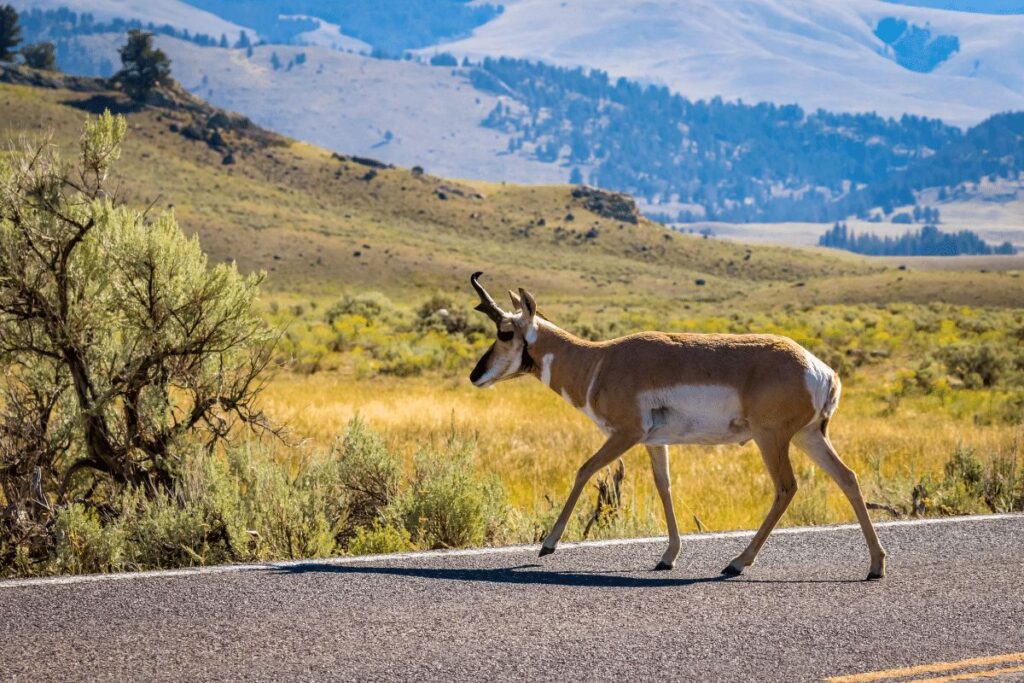
Male pronghorns grow much larger horns than females, which they use to spar with other males during the mating season.
Pronghorns are herbivores that primarily eat grasses and shrubs. They have specially adapted digestive systems that allow them to extract nutrients from plants that other animals cannot digest. Pronghorns are also one of the few animals in Yellowstone that can survive on a diet of sagebrush, which is abundant in the park.
Trumpeter Swans
If you’re lucky, you might spot a trumpeter swan while driving in Yellowstone in the spring! Trumpeter swans are the largest waterfowl in North America, and they’re truly a sight to behold.
These beautiful birds mate for life and typically nest near ponds and lakes. In Yellowstone, trumpeter swans can often be seen swimming or grazing along the shores of Lewis Lake. Keep your eyes peeled and you might just spot one of these majestic creatures!
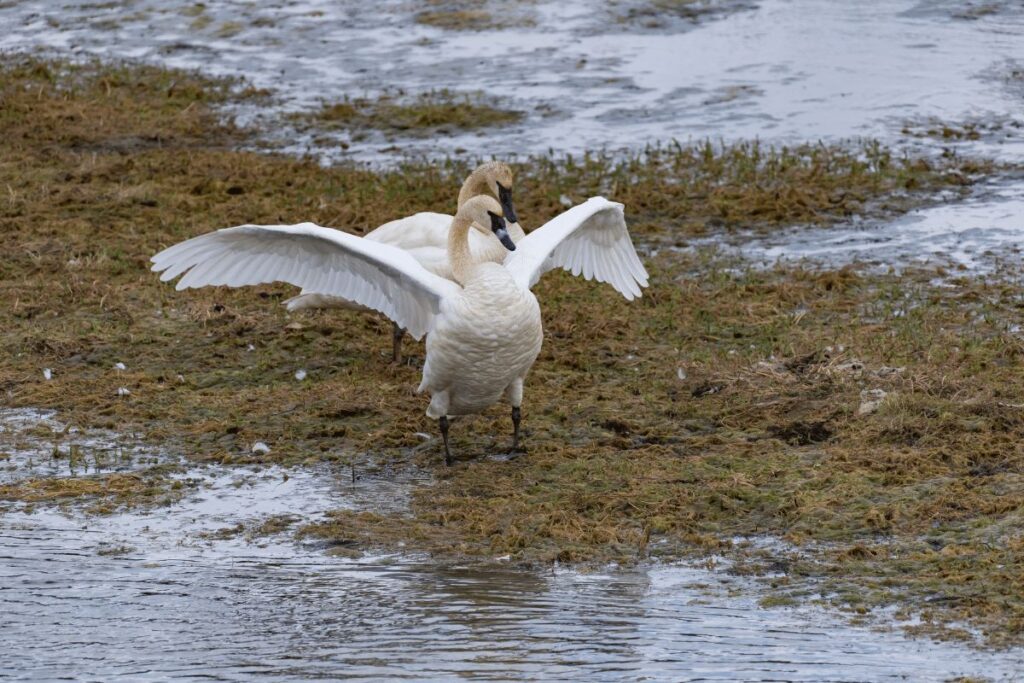
Trumpeter Swans can be found in Yellowstone National Park in several locations, including the Yellowstone River, the Lamar Valley, and the Madison River.
These birds prefer to inhabit wetlands, ponds, and slow-moving streams, making them a common sight near the park’s many bodies of water.
Visitors to the park can also spot Trumpeter Swans at Swan Lake Flats, where the birds often congregate during the winter months.
Badgers
Badgers are very shy and reclusive animals, but when they are out and about, they are sure to leave their mark.
Badgers are nocturnal animals, so they are only active at night. During the day, they will often be seen hibernating in their dens or taking a nap in the sun. When they are awake, badgers will usually be seen foraging for food or patrolling their territory.

Badgers have a variety of different calls that they use to communicate with each other. These calls can range from barks to growls and everything in between. Badgers will also sometimes make a high-pitched squeaking noise when they are excited or alarmed.
Badgers are one of the few animals in Yellowstone that will actually attack humans if they feel threatened. If you see a badger, it is best to give it plenty of space and avoid getting too close.
They are typically active at night and tend to avoid human activity. However, visitors to the park may have a chance to see badgers in open meadows or along the edges of forested areas, especially in the Lamar Valley and Hayden Valley. Badgers are also known to inhabit areas near water sources, such as rivers and streams.
Bald Eagles
Bald eagles are a well-known sight in Yellowstone National Park. Every spring, hundreds of these majestic raptors migrate to the park to take advantage of the abundance of fish in the rivers and lakes.
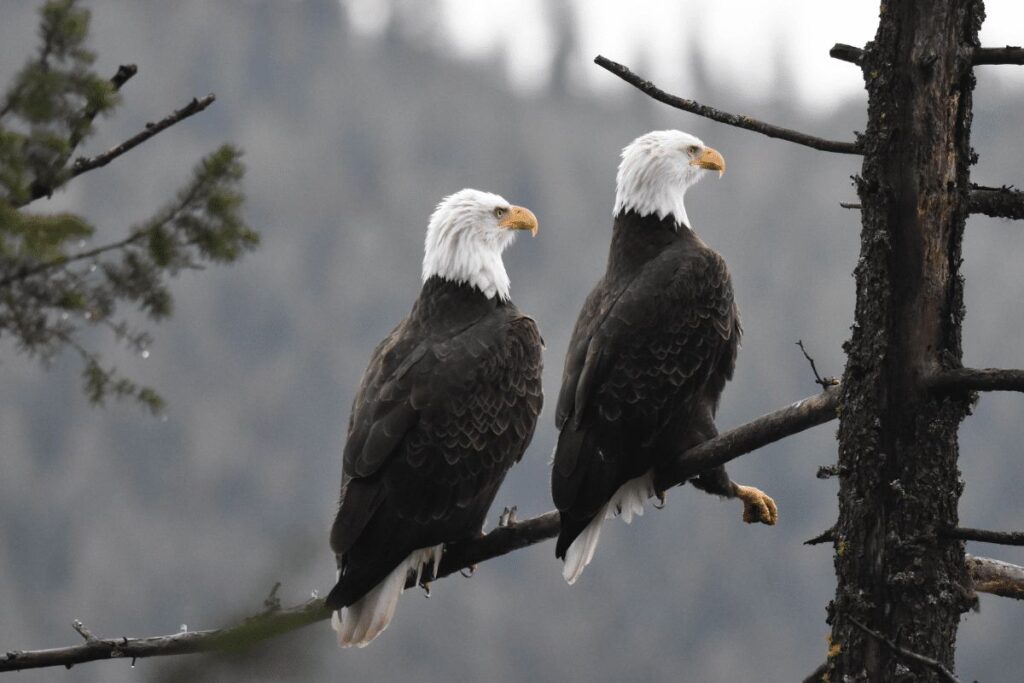
Visitors often catch sight of bald eagles swooping down to snag a fish from the water or perched atop a tree, waiting for their next meal. While most bald eagles migrate south for the winter, some do stay in Yellowstone year-round.
Bald Eagles can be spotted in Yellowstone National Park near bodies of water, particularly along the Yellowstone River, the Madison River, and Yellowstone Lake.
These birds of prey prefer to perch in tall trees or on rocky outcroppings near the water, where they can hunt for fish and other prey.
Visitors to the park can also see Bald Eagles flying overhead or nesting in tall trees, particularly during the spring and summer months when they are breeding and raising their young.
Long Tailed Weasel
The Long-tailed Weasel, also known as the Mustela frenata, is a small carnivorous mammal that can be found in many regions across North America, including Yellowstone National Park. These elusive creatures are known for their excellent hunting skills and can be spotted in various wilderness areas and trails within the park.
One of the best places to see Long-tailed Weasels in Yellowstone is the Lamar Valley. This area is known for its abundant wildlife and is home to many species, including bison, wolves, and elk.
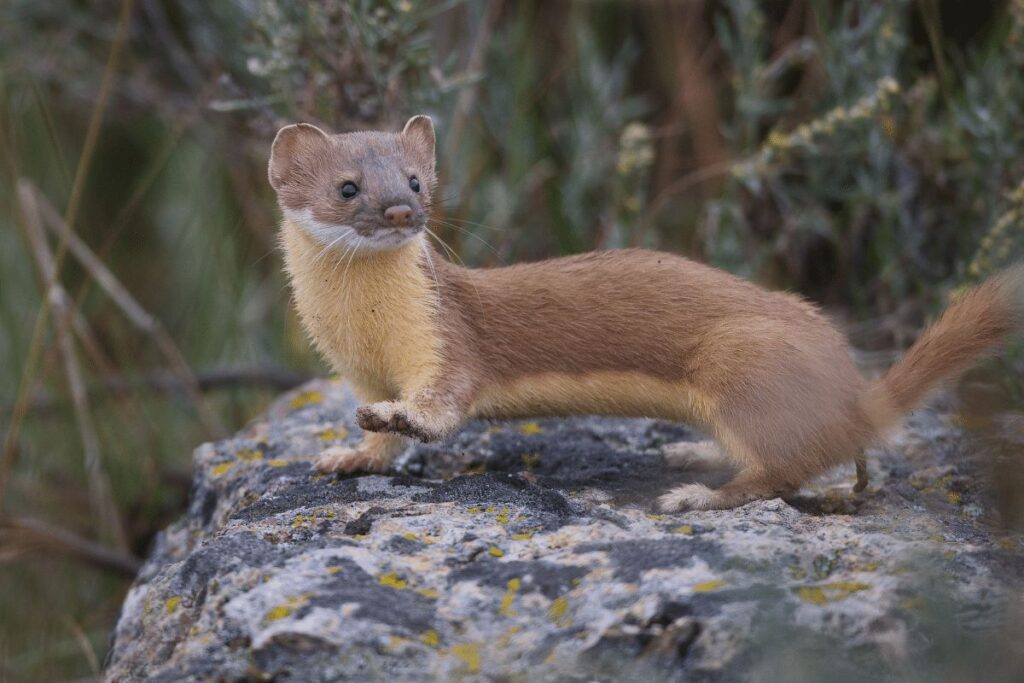
The Lamar Valley is also a popular destination for hikers and backpackers, with several trails leading through the valley and into the surrounding wilderness.
The Pelican Valley Trail is another excellent location to spot Long-tailed Weasels. This trail runs through a beautiful valley and offers stunning views of the surrounding mountains.
The area is also home to several beaver dams, which provide an ideal habitat for these small predators.
The Hellroaring Creek Trail is yet another trail that is known for its Long-tailed Weasel sightings. This trail follows a creek through a lush forest and is a popular destination for birdwatchers and nature enthusiasts. Along the trail, you may also spot other wildlife such as mule deer, coyotes, and black bears.
Long-tailed Weasels are skilled hunters and can often be seen stalking their prey in open meadows or near streams and rivers. They are also known for their agility and can climb trees and swim across water bodies with ease.
If you’re lucky enough to spot one, you’ll likely see them darting quickly through the underbrush or darting across open spaces in pursuit of their prey.
In addition to the Lamar Valley, Pelican Valley Trail, and Hellroaring Creek Trail, Long-tailed Weasels can also be found in other areas throughout Yellowstone National Park. These include the Hayden Valley, the Tower Roosevelt area, and the Bechler Meadows Trail.
Bears Emerging from Hibernation
As the weather warms up in Yellowstone, many animals are emerging from hibernation! This includes the bears! Bears will begin to leave their dens in early to mid-April.
Cubs are usually born in January or February and will stay with their mothers for about two years. For the first few months of their lives, they don’t do much but eat, sleep, and grow!
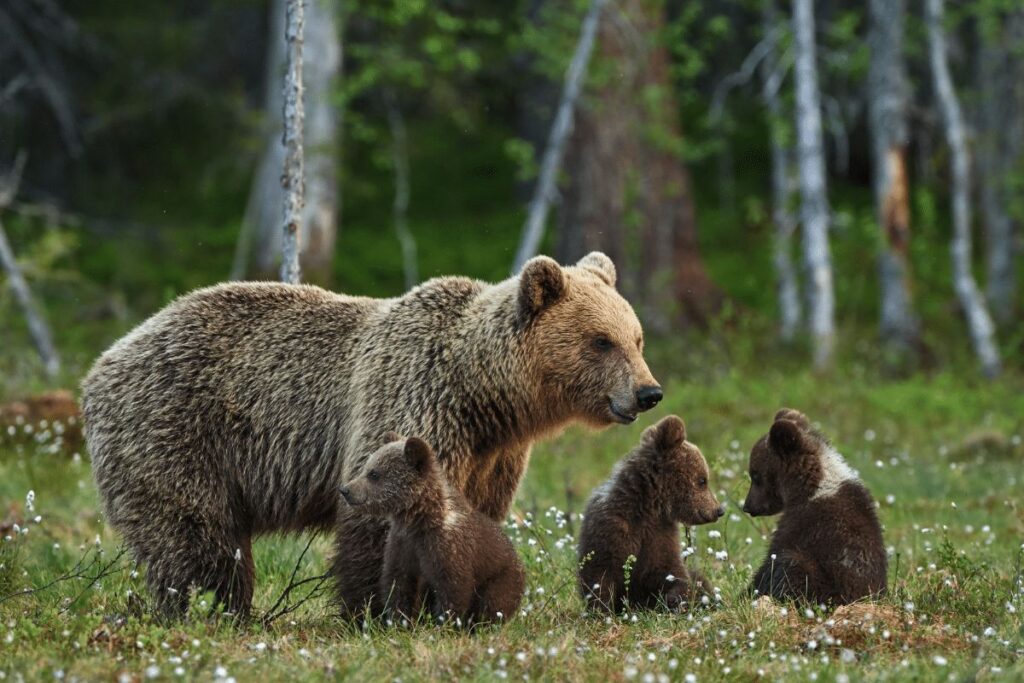
As the weather gets warmer, bears will start to look for food. They will mostly eat plants at this time of year as they prepare for their winter hibernation.
Bearberry, serviceberry, horsetail, and sedges are just some of the plants that bears like to eat. Bears will also prey on small mammals such as ground squirrels, pocket gophers, and mice.
Also Read: 10 Incredible National Parks To See Male Black Bears Emerge From Hibernation!
When driving in Yellowstone in the springtime, be sure to keep an eye out for bears! They may be crossing the road or feeding on the roadside vegetation. If you see a bear, give it plenty of space and do not approach it.
Stunning Lakes In Yellowstone National Park to hike to and see wildlife
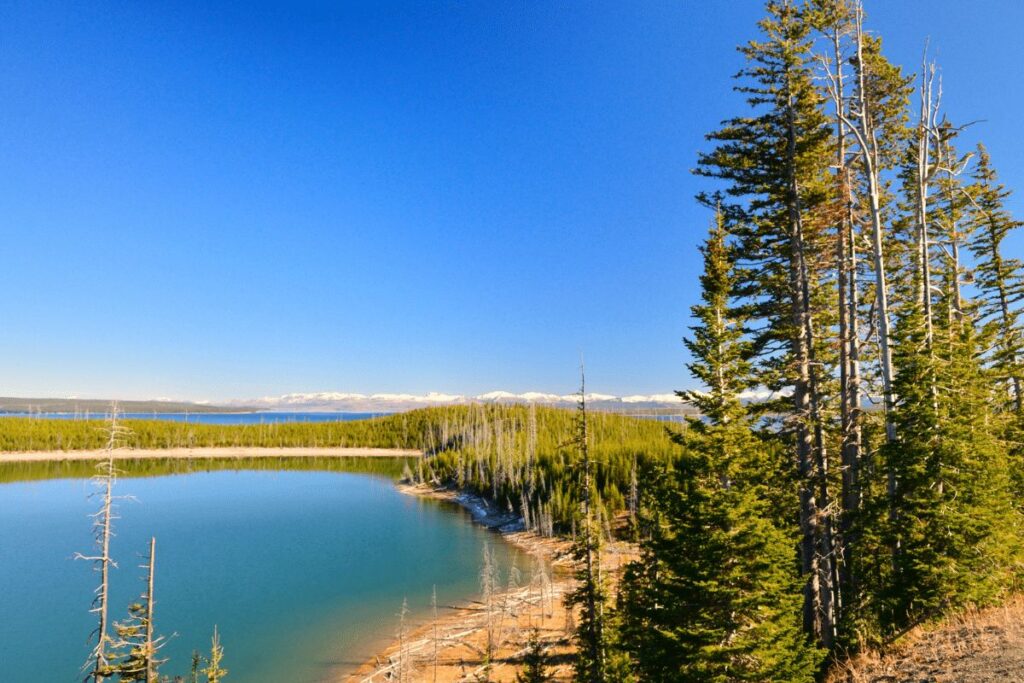
Yellowstone is a photographer’s paradise. The colors are so vibrant and the wildlife is so active that it’s impossible to take a bad photo. Here are some of the best lakes in Yellowstone to hike to and see wildlife:
Also Read: 10 Absolutely Stunning Lakes In Yellowstone National Park (We Hiked To And Camped At All)
1. Mirror Lake: This secluded lake is located in the heart of Yellowstone National Park. It’s a great place to come for a peaceful hike and to see lots of wildlife. You’re likely to see deer, bighorn sheep, and even bears if you’re lucky!
2. Yellowstone Lake: This is the largest lake in Yellowstone National Park and it’s absolutely stunning. There are plenty of hiking trails around the lake so you can explore all that it has to offer. You’re also likely to see plenty of wildlife here, including bison, elk, and bald eagles.
3. Lewis Lake: This beautiful lake is located in the southern part of Yellowstone National Park. It’s a great place to come for a relaxing hike or fishing trip. You might even spot some otters playing in the water!
Towns To Base Your Adventures in Yellowstone
West Yellowstone is the closest town to the west entrance of Yellowstone National Park and is a popular base for visitors interested in exploring the park. The town has a wide range of lodging and dining options as well as numerous outfitters offering guided tours of the park.
Cody is located just outside the east entrance to Yellowstone and is named for famed buffalo hunter William “Buffalo Bill” Cody. The town offers a variety of museums and historical attractions as well as outdoor activities such as horseback riding and whitewater rafting.
Gardiner is the northernmost town located on the border of Yellowstone National Park. This historic town was established in 1880 as a gateway for prospectors heading into the park’s interior. Today, Gardiner is a popular launching point for visitors wishing to explore Yellowstone’s Northern Range region.
Also Read: Discovering Yellowstone National Park: 5 Towns To Base Your Adventures From
Cooke City is situated just outside the northeast entrance to Yellowstone and surrounded by mountains including Absaroka-Beartooth Wilderness. This small town offer LIMITED services but makes an ideal basecamp for those planning extended backcountry adventures in Yellowstone National Park.
Guided Tours in Yellowstone National Park
Yellowstone National Park is teeming with wildlife, and one of the best ways to see them is on a guided tour.
There are many different types of tours available, from ranger-led walks to safari-style Jeep excursions.
Also Read: 30+ Best Things To Do In Yellowstone National Park (All Inclusive Guides Trips!)
You can even take a horseback ride through some of the most beautiful parts of the park. No matter what type of tour you choose, you’re sure to see plenty of animals and learn about their behavior and habitats.
Also Read: Discover Yellowstone National Park: 7 Tailor-Made Experiences
Want to uncover the true gems of Yellowstone? Dive into our comprehensive list of 10 Unforgettable Lakes in Yellowstone that we hiked to and camped at, just for you!
Conclusion
Exploring Yellowstone National Park in the springtime is a fantastic way to see some of nature’s most beautiful and impressive animals.
From majestic bison to cute otters, there are plenty of opportunities for animal lovers and casual observers alike to spot creatures they wouldn’t normally come across while out on their drives.
Whether you’re in search of a specific species or just keeping your eyes peeled for something unusual during your drive through this amazing park, make sure you take the time to appreciate all that Yellowstone has to offer — from its spectacular wild inhabitants as well as its stunning natural beauty.

